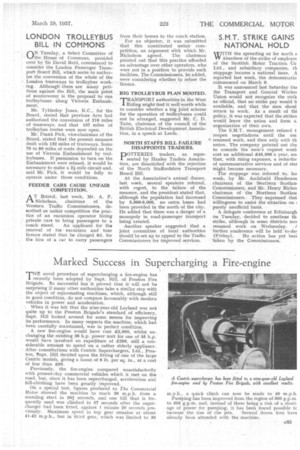Marked Success in Supercharging a Fire-engine
Page 113

If you've noticed an error in this article please click here to report it so we can fix it.
THE novel procedure of supercharging a fire-engine has recently been adopted by Supt. Hill, of Preston Fire Brigade. So successful has it proved that it will not be surprising if many other authorities take a similar step with the object of rejuvenating machines, which, although still in good condition, do not compare favourably with modern vehicles in power and acceleration.
When it was felt that the nine-year-old Leyland was not quite up to the Preston Brigade's standard of efficiency, Supt. Hill looked around for some means for improving its performance. In many respects the machine, which had been carefully maintained, was in perfect condition.
A new fire-engine would have cost £2,000, whilst exchanging the existing 36 h.p. power unit for one of 55 h.p. would have involved an expediture of £290, still a considerable amount to spend on a rather elderly appliance. After consultations with Centric Superchargers, Ltd., Preston, upt. Hill decided upon the fitting of one of the large Centric models, giving a boost of 6 lb. per sq. in., at a cost of less than £90.
Previously, the fire-engine compared unsatisfactorily with present-day commercial vehicles which it met on the road, but, since it has been supercharged, acceleration and hill-climbing have been greatly improved.
On a special test, figures produced to The Commercial Motor showed the machine to reach 30 m.p.h. from a standing start in 30f seconds, and one hill that is frequently used was climbed in 57 seconds after the supercharger had been fitted, against 1 minute 20 seconds previously. Maximum speed in top gear remains at about 41-42 m.p.h., but in third gear, which was limited to 30
m.p.h., a quick climb can now be made to 40 mph. Pumping has been improved from the region of 300 g.pan to 500 g.p.m. and, instead of there being a risk of a shortage of power for pumping, it has been found possible tc increase the size of the jets. Several dozen fires have already been attended with the machine.
























































































































































